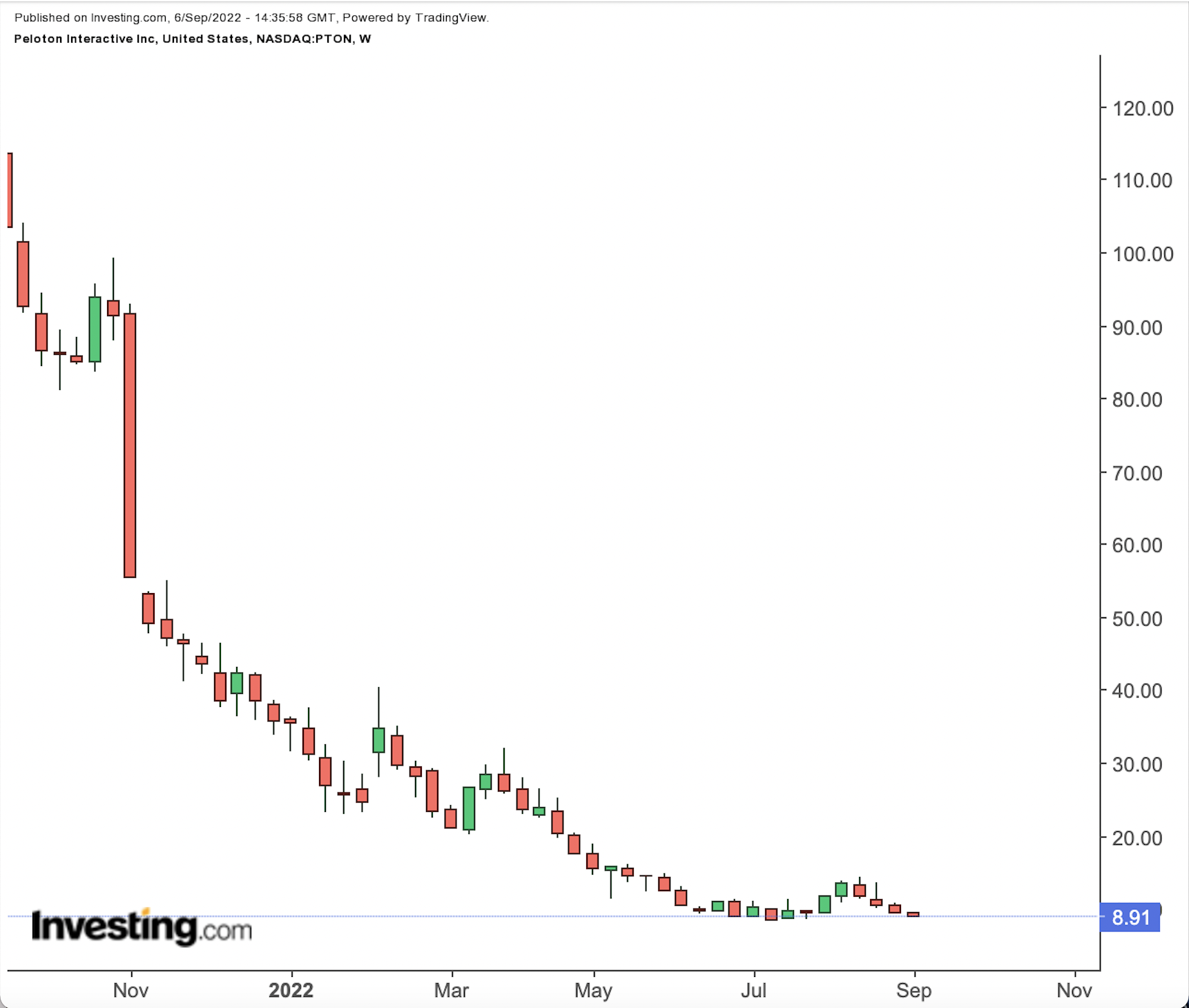Boeing launches virtual pilot training platform
- Peloton's fundamentals are awful and suggest a high likelihood of near-term bankruptcy
- The company is working to improve its situation, and some of the strategic moves may well work
- But two key roadblocks remain toward turning bullish, even with PTON down 94% from last year's high
Fundamentally speaking, Peloton Interactive (NASDAQ:PTON) is on a path to bankruptcy, and in a hurry.
Peloton did finish its fiscal year 2022 (ending June 30) with $1.25 billion in cash. More cash should come in from the sale of manufacturing assets. But the company's free cash flow in FY22 was -$2.4 billion. Even accounting for a planned $800 million in cost savings, at this rate, Peloton is going to run out of money no later than 2024.
Of course, Peloton and its chief executive officer, Barry McCarthy, know that. McCarthy previously was the chief financial officer at both Spotify Technology (NYSE:SPOT) and Netflix (NASDAQ:NFLX), not that it takes CFO experience to understand that simple math. And so, McCarthy has detailed a number of strategies to restore Peloton's financial health and return the company to growth.
It's not difficult to be somewhat intrigued by the potential here. Peloton's recent results are awful, certainly, but there's still a satisfied customer base and an attractive stream of subscription revenue. McCarthy speaks passionately about the opportunity here and has brought in experienced executives to help drive a turnaround.
All told, bankruptcy looks far less likely than FY22 results would suggest. But for two core reasons, neither that nor the 94% decline from January 2021 highs are enough to make PTON stock a buy.

Source: Investing.com
Trying Everything
Again, McCarthy is well aware of his company's challenges. At the end of the fourth quarter shareholder letter, the CEO told a personal story about a rescue at sea. He was alluding to a well-known financial metaphor: that turning around a company is like turning around a cargo ship. It takes time, patience, and care.
After a fiscal year in which Peloton's product revenue declined 30%, the company clearly needs a turnaround. In response, McCarthy has detailed a number of initiatives.
As noted, the company aims to save about $800 million in annual spending through a variety of measures. Better design should reduce the cost of producing bikes and other fitness machines. After spending hundreds of millions to build out owned manufacturing capacity, Peloton is outsourcing production and doing the same with last-mile delivery.
Peloton is changing its go-to-market strategy as well. Most notably, the company announced last month that it would sell via Amazon.com (NASDAQ:AMZN), a decision that led to a brief rally in PTON stock. It's targeting more value-sensitive shoppers through pilot offerings of pre-owned equipment and a lease option. It will even ship products that require assembly, another way to offer lower-priced products (and cut costs).
Peloton long refused to separate its app from its hardware or to consider a so-called “freemium” strategy. Both efforts now are on the table.
Some of these initiatives aren't going to work. McCarthy himself said on the fourth-quarter conference call that leasing could be a "nuclear bomb" that would ruin the business or a "path to the promised land." Peloton, thus, is moving slowly with the pilot so it can properly understand retention rates and the impact of lost sales.
But some may well work. McCarthy's broad aim is to expand Peloton's addressable market, bringing in customers for whom the product right now is a bit too expensive. And those new customers can change the business because they will drive growth in subscription revenue — which is where the real money (and profits) are.
Indeed, there's another so-called “pandemic winner” with a similar profile: Roku (NASDAQ:ROKU). Roku loses money on its players but makes up for it with revenue from advertising and fees paid by streaming services (so-called “platform revenue”). Given that Peloton's subscription revenue has gross margins of 68%, a figure that should move even higher as revenue increases, that kind of model could work here.
Two Big Problems With PTON Stock
But there are two core problems here. The first is that Peloton, even down 94%, still has a market capitalization of about $3.5 billion. I wrote this spring that the stock, at $15, wasn't cheap. Below $10, that problem still holds.
Assume that Peloton can get the product business to run at about breakeven, and use subscriptions to generate profit. In FY22, overall adjusted EBITDA (earnings before interest, taxes, depreciation, and amortization) loss still totaled $983 million.
Even with another $650 million or so in cost savings on the way (over a period of years), Peloton still needs another $300-million-plus just to get to breakeven. That requires roughly one-third growth in subscription gross profit — and, again, that's only getting the company to breakeven adjusted EBITDA. To get to positive free cash flow, it requires several years of consistent subscription growth. To support a $3.5 billion market cap requires even more.
Optimists might believe that can happen. But that gets to the second problem: fitness consumers are notoriously fickle. The industry has been a graveyard for investor capital. Equipment manufacturer Nautilus (NYSE:NLS) now trades at $2 and is down 16% over the past 10 years. It ran past $20 in the middle of the last decade and briefly cleared $30 last year. Multiple club operators, among them Bally Total Fitness and Town Sports International (OTC:CLUBQ), have wiped out shareholders.
It's certainly possible that this works. But 'possible' isn't enough for investors to put hard-earned money into Peloton stock, at least at this valuation.
Disclaimer: As of this writing, Vince Martin has no positions in any securities mentioned.
